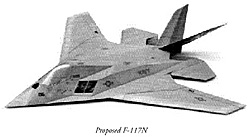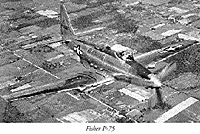 Proposed F-117N Lockheed--Martin
Proposed F-117N Lockheed--Martin
All wargaming is make-believe. Even the most historcal scenario, authentic in order of battle, rules, and victory conditions, still has one element of fantasy: The commanders. "What if I were Burke? Could I do better than Nagumo?" We want to feel the pressure of command, understand the problems they faced. Did they make the right decision? What would have happened if he/I did this instead?
But there are only so many historcal scenarios, and we don't play wargames just to put ourselves in the commander's shoes. A lot of us love the hardware: Armored vehicles, ships, and aircraft demand our interest, sometimes to the exclusion of other more important aspects of military art. Often, the most interesting hardware is the stuff that was never built. And might-have-beens are a natural for wargaming. It's an artifical world. You can research a plane that was almost built or a ship that was designed but never laid down and make it just as real as any weapon that was ever built, at least in your game. Would it have been effective? Would it have made a difference? Doesn't it look great?
While every nation in every era has its share of hypotheticals, there are two periods that are a gold mine of unfinished projects: Germany at the end of World War II, and the Soviet Union at the end of 1980's. Both were tyrannies with powerful militaries, and their collapse left unfinished designs and prototypes scattered across the military landscape. New books on "Nazi Wonder Weapons" appear every year, and we're just now finding out about some of the Soviet designs that never saw the light of day.
So what's my beef? Often, players incorporating hypotheticals into a scenario simply copy the stats from the reference into a game without change, or without understanding capability of the hardware to perform as adverised. This goes a long way back. In Hector C. Bywater's novel The Great Pacific War, he created ship classes based on his understanding of naval technology at the time (1929). He extrapolated a "modern heavy cruiser" for the US that came close to the mark, but his aircraft carriers were way off, typically with complements twice what ships of that size could reasonably carry. And Hector was no slouch. He was an experienced naval analyst and had served as a British Intelligence agent in WW I, reporting on German ship construction by personally observing their shipyards.
In Biplanes & Battleships, we'll list Hector's carriers as he intended them to operate, but we'll add a warning and our own estimate of what a reasonable aircraft complement should be. There are also many cases of designs that did not work as well as intended. Many of the cool-looking might-have-beens weren't produced in quantity because when they built a prototype, it didn't match the planned performance.
 Fisher P-75
Fisher P-75
Remember the P-75 Eagle? Looks great, good design concept. Built in 1943 as a long-range escort fighter, its "handling characteristics were not as anticipated." It was a dog. Fisher didn't mean to build a cement truck, but that's what they got. And bad designs can make it into combat. Misjudgement or operational need or political pressure can put good men in bad airplanes. Remember the Bf 210? The F7U Cutlass? The P-400?
The Unknown
The interesting thing about hypotheticals is the unknown. They never had their chance. I submit that what gamers are trying to capture with a might-have-been is that feeling of uncertainty. More than a particular platform, more than a particular set of specifications, that sense of novelty and the unknown are what make the game fun. If I pull up specs on the Martin-Baker MB.5 and put it in CaS, the only way you'd be able to tell it never served is if you read it in the remarks. Uncertainty (the "U" factor) about a particular design can grow or shrink as it is developed. A paper design, with only the engineer's calculations of its ability, carries the greatest uncertainty. The P-75 was designed using many standard components, and did not stress the technology of the time, but it was a failure, and did not match the calculations.
The U factor is reduced once the plane is in prototype. It can be tested, fixed, modified, until it either reaches spec or is given up as a lost cause. It's still present even when the first batch enters service. Combat is a far tougher test that anyone can imagine. The SBD Dauntless had problems in 1942 because bombsights fogged up during its attack run as it left the cooler upper altitudes and dove into the moist sea-level tropical air. Mature aircraft of course have a "U"factor of zero, or virtually so.
Periods of rapid technological change can radically increase the "U" factor, as well as producing some really strange-looking prototypes. Uncertainty can be a pleasant surprise as well as bad news. Some designs perform much better than expected, allthough this is not as common as the designers would like. The new USS Seawolf is an example. Trials showed her to be 10% faster than expected. How can we use this in a tactical game?
First: A Scenario
First, imagine a scenario where a new aircraft or ship will enter combat for the first time. No amount of preparation or training can completely tell a user how it will behave in action. No amount of intelligence can tell the enemy exactly what the new weapons will do.
There are three sets of specifications for any weapon: What the enemy believes it will do, what the builder thinks it will do, and what it actually will do. The referee setting up the game can choose a hypothetical unit, a ship or plane, take the published data, and vary it, within reason (try ąD6*3%). It's easier to vary aircraft than ships, obviously.
For a plane, vary its speed, change is ceiling or its maneuver rating, change its armament (e.g., replace six .50 cal with 4 20mm and reduce its maneuver rating by .5). For slightly lesser effects, reduce its endurance or its mechanical reliability.
For a ship, increase its armor (at the cost of some speed), give it a newer model gun, or remove its torpedoes (unexpected topweight). Give the weapon's player the revised specifications and let him make his plan accordingly. The enemy player has the original data as his "intelligence."
Meanwhile, the referee can leave those new specifications alone, or add other "surprises." Perhaps at full combat load on unimproved runways, the plane's landing gear is prone to failure. Maybe the plane proves to be well constructed, and resists more damage than expected. In some cases, depending on the government type, a new plane may suffer sabotage on the assembly line, like the Me 262 and Me 162. This not only imposes casualties on idividual planes, but may be mistaken for some chronic design flaw.
For a ship, perhaps its hull or its engineering plant is more succeptible to shock than was supposed. Perhaps the new guns are more stable (and more accurate) than expected. These are all things that have happened before and will happen again.
Second, imagine a referee setting up a campaign. He allows each side to choose from a short list of hypothetical platforms as part of their order of battle. These may be weapons available to the players at the start of the campaign, or reinforcements that arrive some time later. Depending on the type of campaign, they might all be one type, e.g., aircraft, or a mix of ships, aircraft, or armored vehicles, with point values assigned by the referee ("Want the Graf Zeppelin and her air group? You'll have to give up the Triebflugel squadron and that battalion of Panther Gs").
Actual Performance May Vary...
Once the player has made his choice, the referee can then determine the actual performance of the new weapons. Depending on when they appear in the campaign, the uncertainty factor varies:
- Available at game start: These would be weapons that have finished their development, and would have a low U factor.
Available as early reinforcements: These might be weapons that are near completion, and have been rushed through test. They will have a larger U factor, unless the player wants to delay their arrival and allow for a more complete test program.
Available as late reinforcements: These would be weapons still in the development or possibly even the design phase. The player making the choice will have only the initial design requirements as a guide. Once he commits to the weapon, there may be delays with the development process or the design specifications may change. Certainly these weapons will have the highest U factor.
Other things that influence the U factor relate to the type of weapon that is being developed. In general, ships have a much lower U factor than aircraft, although mistakes can be made.
Evolutionary developments will have a low U factor. For instance, the P-40 was a development of the P-35. The Ki.100 was a variant of the Ki.61 Hien. Both involved new engines and other minor modifications, and were successful developments. The F-117N, listed on page 30, is an evoutionary development of the F-117. Ship refits, where the weapons systems are altered, fall into this category.
Still, someone can screw up. New designs based on existing technology have a moderate U factor. The P-75 Eagle, discussed above, is an example, but almost all aircraft and ship designs go here. New designs based on new technology will have a very high U factor. These include such things as jet propulsion in WW II or guided missile systems for ships or aircraft. The S-37 Berkut, listed on page 31, is in this category, because of its forward-swept wing. Because the principles behind it are not fully understood, errors or oversights may not be discovered until development is well underway.
Finally, looking at weapons design over history, later designs will have a higher U factor than earlier ones. The F-4 had a higher U factor than the P-51, and F-22 has a higher U factor still. Computer simulation and a better understanding of physics has removed some of the unknowns, but complex flight and weapons systems have added much more. The Australian Collins class submarine's main development headache has been "combat systems integration."
The Vonder Veapon Idea Guide on this page can be used as a guide by referees trying to add uncertainty to a new weapon's appearance. They suggest possible changes or problems for a weapon. They are not exclusive, and no table will replace thorough research and a good basic understanding of weapons technology and how they are developed.
Go - read books on planes and ships and tanks. It's research.
BT
Back to The Naval Sitrep #19 Table of Contents
Back to Naval Sitrep List of Issues
Back to MagWeb Master Magazine List
© Copyright 2000 by Larry Bond and Clash of Arms.
This article appears in MagWeb (Magazine Web) on the Internet World Wide Web.
Other military history articles and gaming articles are available at http://www.magweb.com